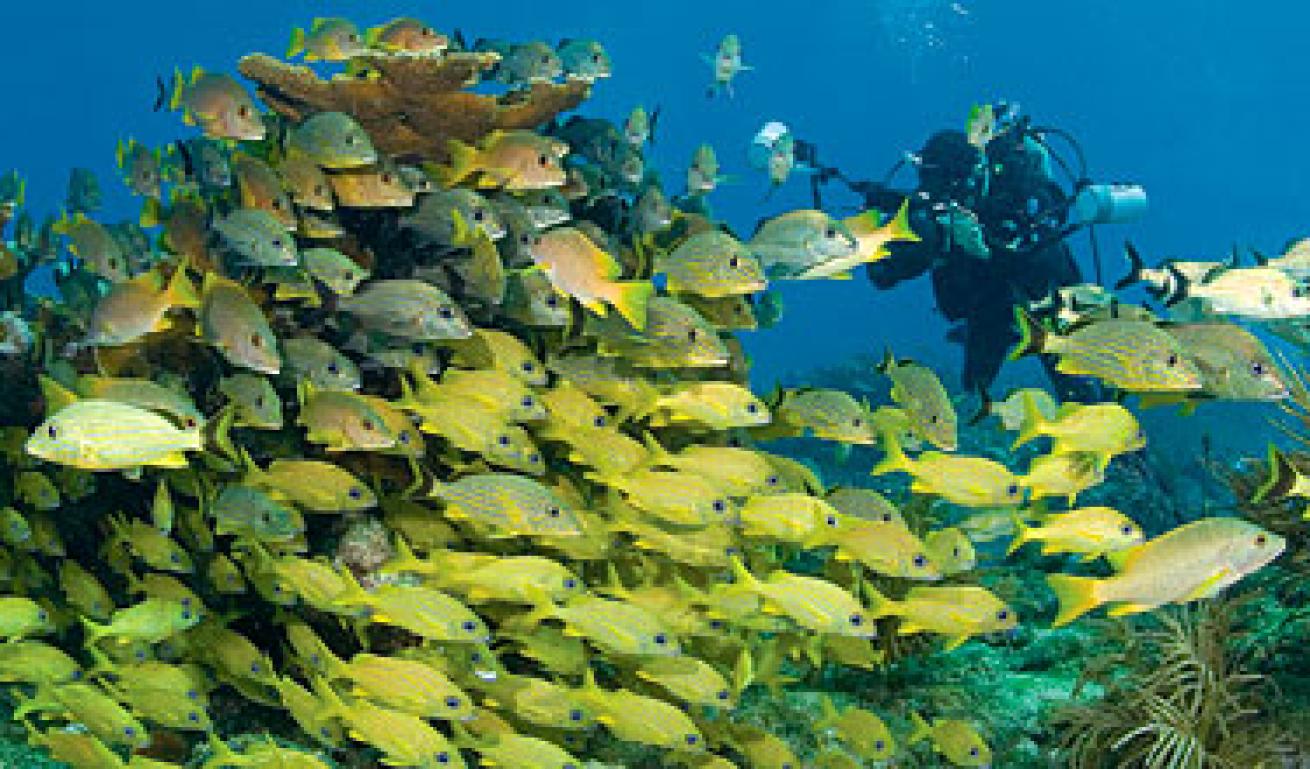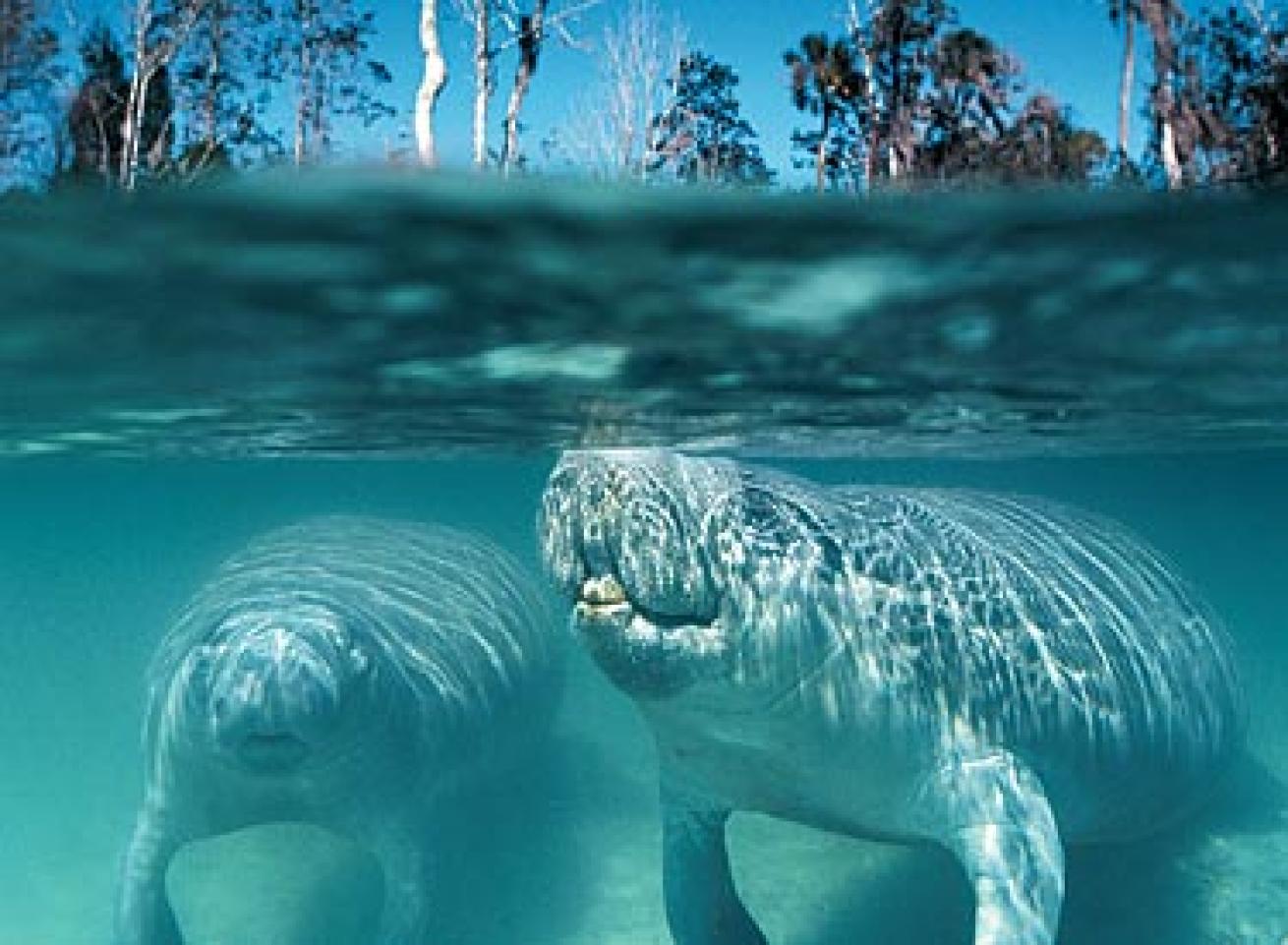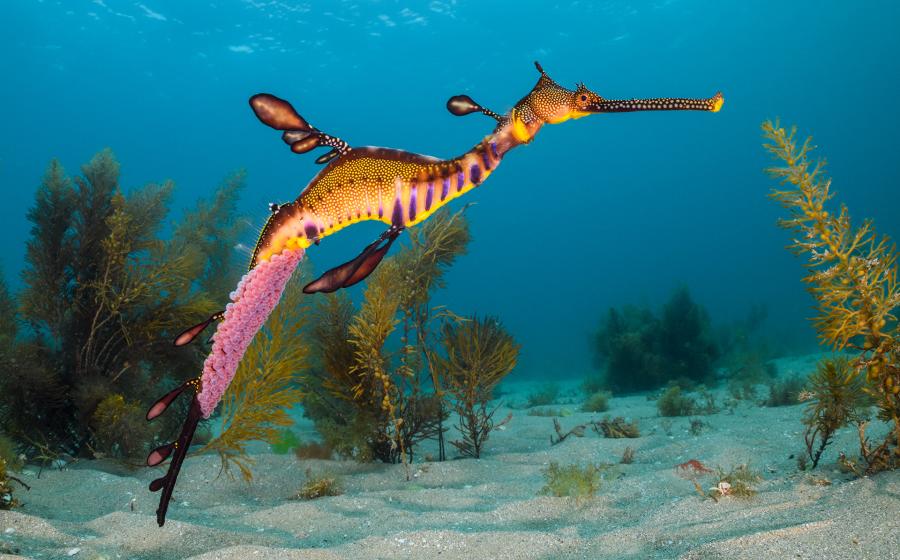Florida & The Florida Keys
Florida Keys


The Middle Keys have some great dive sites, but they are spread farther apart. Highlights include dolphins, stingrays, nurse sharks, Bermuda chub and sergeant majors. Continuing down Highway 1, don't miss Looe Key's spur-and-groove reefs in 12 to 35 feet of water; public camping is available at nearby Bahia Honda State Park.
On to historic Key West, which is neatly tucked away at the end of the Keys' western curve, protected from the harsh north and northeastern winds, which allows marine species to thrive. Flamingo tongues crawl on red sea fans and pink-hued sponges, and the fishy hulls of wrecks offer history lessons from a bird's-eye view. One particularly interesting wreck is the Cayman Salvage Master, built in 1937 for mining. Before it sank in 1985, it also served as a cable layer, a research vessel, a freighter and finally, a salvage vessel for the Cayman Islands. In 1980, the ship was confiscated for carrying illegal Cuban refugees and, after sitting idle at the dock, it sank due to neglect. Refloated, the ship was designated to be sunk in deep water as a sportfishing magnet, but on its way it sank prematurely, landing on its port side in 90 feet. Later that year Hurricane Kate rolled the ship upright, where you can see her today, 5.5 nautical miles south of Key West. And that's the way stories go on this Mile Marker 1 island, a bit quirky and not easily forgotten.
Dive In
Weather: Temps are mild year-round with hot, humid summers and mid-winter lows in the 50s to 60s.
Average Water Temp: High 70s to low 80s in summer; low 70s in winter.
Average Vis: Typically averages 40 to 75 feet, with 100 feet on calm days, but wind and waves can reduce vis dramatically.
Travel Savvy: Drive the whole Overseas Highway for an ideal introduction to the Keys. You can fly into Miami or Key West and drive the length of the highway from either direction.
Destination Links: www.fla-keys.com.
Florida

For divers, the Sunshine State has it all. Florida's Panhandle and Gulf Coast is a seascape of wrecks, towers and ledges, all brimming with supersized fish. Just miles off some of the Panhandle's coast hundreds of ships and artificial reef structures dot the ocean floor. And at press time, the 888-foot aircraft carrier Oriskany was scheduled to be sunk off Pensacola in mid-May. Off Florida's west coast (Tampa/Clearwater, Sarasota, Ft. Myers, Naples), several coastal communities have enacted aggressive artificial reef programs, sinking everything from ships and barges to demolished bridge sections and decommissioned military vehicles.
Linked together by a netherworld of flooded caves, there are hundreds of springs flowing from the forest floor of north Florida. Here in the heart of what natives like to call "the real Florida," you're never far from a dozen or so of the best freshwater dives in the state. All you need are your wheels and dive gear.
Off Florida's Atlantic coast you can sample the artificial reefs off the Jacksonville and St. Augustine area and Daytona Beach before wandering down I-95 to the Gold Coast-Palm Beach, Broward and Dade counties-where there is a world-class collection of both natural and artificial reefs.
Dive In
Weather: Mild temperatures year-round in the south and more temperate north of Cape Canaveral. In winter, daytime temps can dip into the 40s in the north, while anything below 50 degrees is unusual in the south. Summers are hot and humid throughout the state.
Average Water Temp: Upper 70s in summer, winter temps vary by location, from the low 70s in South Florida to mid-50s in the north. Water in the springs remains a constant 72 degrees year-round.
Average Visibility: Vis in the springs can be 150-feet-plus; ocean water clarity varies by season and location, ranging from 30 feet on a blustery winter day to more than 100 feet in mid-summer.
Travel Savvy: Free vacation guides are available on the Florida Tourism web site at www.flausa.com/planning/guide.
Destination Links > Florida Tourism Agency, www.flausa.com.
Florida Keys


The arced line of islands that comprise the Florida Keys is a diver's paradise, but each island has its own appeal. At the beginning of the 112-mile-long Overseas Highway is Key Largo, the longest island in the Keys and an incredible dive mecca with more dive sites than mile markers. The famous Christ of the Deep statue is here, which serves as the backdrop to many underwater weddings. Wrecks include the Spiegel Grove, the Civil War Wreck and the sister wrecks Bibb and Duane, which double-teamed as weather stations and rescue ships in the North Atlantic and now rest a quarter mile apart. From Key Largo you can drive north and visit Biscayne National Park, but most divers head south, down the long corridor that eventually ends in sunny Key West. But that isn't the end of the Keys: 55 nautical miles west are the Dry Tortugas, where historic Fort Jefferson offers terrific snorkeling on the outer face of its moat wall, and if you have boat access, the Windjammer wreck lies in two pieces piled high with dense mounds of star and brain coral.
The Middle Keys have some great dive sites, but they are spread farther apart. Highlights include dolphins, stingrays, nurse sharks, Bermuda chub and sergeant majors. Continuing down Highway 1, don't miss Looe Key's spur-and-groove reefs in 12 to 35 feet of water; public camping is available at nearby Bahia Honda State Park.
On to historic Key West, which is neatly tucked away at the end of the Keys' western curve, protected from the harsh north and northeastern winds, which allows marine species to thrive. Flamingo tongues crawl on red sea fans and pink-hued sponges, and the fishy hulls of wrecks offer history lessons from a bird's-eye view. One particularly interesting wreck is the Cayman Salvage Master, built in 1937 for mining. Before it sank in 1985, it also served as a cable layer, a research vessel, a freighter and finally, a salvage vessel for the Cayman Islands. In 1980, the ship was confiscated for carrying illegal Cuban refugees and, after sitting idle at the dock, it sank due to neglect. Refloated, the ship was designated to be sunk in deep water as a sportfishing magnet, but on its way it sank prematurely, landing on its port side in 90 feet. Later that year Hurricane Kate rolled the ship upright, where you can see her today, 5.5 nautical miles south of Key West. And that's the way stories go on this Mile Marker 1 island, a bit quirky and not easily forgotten.
Dive In
Weather: Temps are mild year-round with hot, humid summers and mid-winter lows in the 50s to 60s.
Average Water Temp: High 70s to low 80s in summer; low 70s in winter.
Average Vis: Typically averages 40 to 75 feet, with 100 feet on calm days, but wind and waves can reduce vis dramatically.
Travel Savvy: Drive the whole Overseas Highway for an ideal introduction to the Keys. You can fly into Miami or Key West and drive the length of the highway from either direction.
Destination Links: www.fla-keys.com.
Florida

For divers, the Sunshine State has it all. Florida's Panhandle and Gulf Coast is a seascape of wrecks, towers and ledges, all brimming with supersized fish. Just miles off some of the Panhandle's coast hundreds of ships and artificial reef structures dot the ocean floor. And at press time, the 888-foot aircraft carrier Oriskany was scheduled to be sunk off Pensacola in mid-May. Off Florida's west coast (Tampa/Clearwater, Sarasota, Ft. Myers, Naples), several coastal communities have enacted aggressive artificial reef programs, sinking everything from ships and barges to demolished bridge sections and decommissioned military vehicles.
Linked together by a netherworld of flooded caves, there are hundreds of springs flowing from the forest floor of north Florida. Here in the heart of what natives like to call "the real Florida," you're never far from a dozen or so of the best freshwater dives in the state. All you need are your wheels and dive gear.
Off Florida's Atlantic coast you can sample the artificial reefs off the Jacksonville and St. Augustine area and Daytona Beach before wandering down I-95 to the Gold Coast-Palm Beach, Broward and Dade counties-where there is a world-class collection of both natural and artificial reefs.
Dive In
Weather: Mild temperatures year-round in the south and more temperate north of Cape Canaveral. In winter, daytime temps can dip into the 40s in the north, while anything below 50 degrees is unusual in the south. Summers are hot and humid throughout the state.
Average Water Temp: Upper 70s in summer, winter temps vary by location, from the low 70s in South Florida to mid-50s in the north. Water in the springs remains a constant 72 degrees year-round.
Average Visibility: Vis in the springs can be 150-feet-plus; ocean water clarity varies by season and location, ranging from 30 feet on a blustery winter day to more than 100 feet in mid-summer.
Travel Savvy: Free vacation guides are available on the Florida Tourism web site at www.flausa.com/planning/guide.
Destination Links > Florida Tourism Agency, www.flausa.com.






